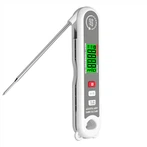Introduction to microscope objective lens magnification
gain
The magnification of the objective lens refers to the ability index of the objective lens to magnify the multiple of the real object on the linear length. There are two representation methods, one is to directly mark 8×, 10×, 45×, etc. on the objective lens; the other is to mark the focal length f of the objective lens on the objective lens, the shorter the focal length, the higher the magnification . The magnification formula of the former objective lens is M object = L/f object, L is the length of the optical lens barrel, and the L value is very accurate in design, but in practical application, because it is not easy to measure, the length of the mechanical lens barrel is often used. The length of the mechanical lens tube refers to the linear distance from the interface of the microscope eyepiece. The mechanical tube length is numbered on each objective.
Lens barrel length
The lens barrel length refers to the distance from the bottom surface of the objective lens to the top surface of the eyepiece. Since the aberration of the objective lens is corrected based on the image of a certain position, the objective lens must be used on the specified length of the mechanical lens barrel. The length of the mechanical lens barrel of a general microscope is mostly 160mm, 170mm, [3] 190mm. When the metallographic microscope is taking pictures, the image projection distance varies greatly due to the different magnifications. Therefore, the aberration of the excellent objective lens is corrected according to the length of the lens barrel, that is, within the infinitely long range, the objective aberration has been corrected.
Numerical aperture
The numerical aperture represents the light-gathering ability of the objective lens and is one of the important properties of the objective lens, usually expressed in "NA". The numerical aperture of the objective lens determines the resolving power (identification) and effective magnification of the objective lens. According to the theoretical derivation: NA=nsinθ There are two ways to increase the numerical aperture of the objective lens:
⑴ Increase the diameter of the lens or reduce the focal length of the objective lens, that is, design an objective lens with a short focal length to increase the aperture half-angle θ. However, this method will lead to increased aberrations and manufacturing difficulties, and is generally not used. In fact, the maximum value of sinθ can only reach 0.95.
(2) Increase the refractive index n between the objective lens and the observed object. The interfering objective lens is air as the medium, and the refractive index n=1, which is generally used for low magnification objective lens. Oil-based objective lenses often use pine oil (n=1.515, NA=1.4) and α-one-generation bromonaphthalene (n=1.658, NA=1.60) as the medium for high-magnification objective lenses. The numerical aperture of the oil objective lens can reach 1.30~1.40 at this time, and its magnification can reach 100~140 times. But you can't just use oil as a medium for the relevant objective lens.
The minimum numerical aperture series, parameters, color circle and symbol of the objective lens
Marking of objective lens
Different markings are engraved on the objective lens shell, such as immersion mark, objective lens category, magnification, numerical aperture, mechanical barrel length, and cover glass thickness. Oil: indicates that the immersion liquid is pine oil; 100×/1.25: indicates that the magnification of the objective lens is 100 times, and the numerical aperture is 1.25; 160/0: indicates that the length of the mechanical lens barrel is 160 mm; “0” indicates no cover glass. Some objective lenses are engraved with 160/-: indicating that the length of the mechanical lens barrel is 160mm. "-" indicates optional coverslip. A colored circle engraved on the objective lens indicates the magnification of the objective lens. High magnification objectives are usually oil immersion systems, and the oil lens is represented by "oil" (or OiI, ÖL, HL) or a black circle painted on the housing.
Discrimination ability of objective lens
The distinguishing ability of the microscope is mainly determined by the objective lens. The discrimination ability of the objective lens can be divided into plane and vertical discrimination ability. Objective lens The objective lens is the most important optical unit that determines the basic performance and functions of an optical microscope. Therefore, in order to meet various needs and applications, we have developed objective lenses with the best optical performance and functions, which are also the most important performance and functions for optical microscopes, and launched a variety of objective lens products that can meet different usage purposes . Basically, objective lenses are classified by usage, observation method, magnification, performance (aberration correction), etc. Among them, the classification by aberration correction is a classification method unique to microscope objectives.






